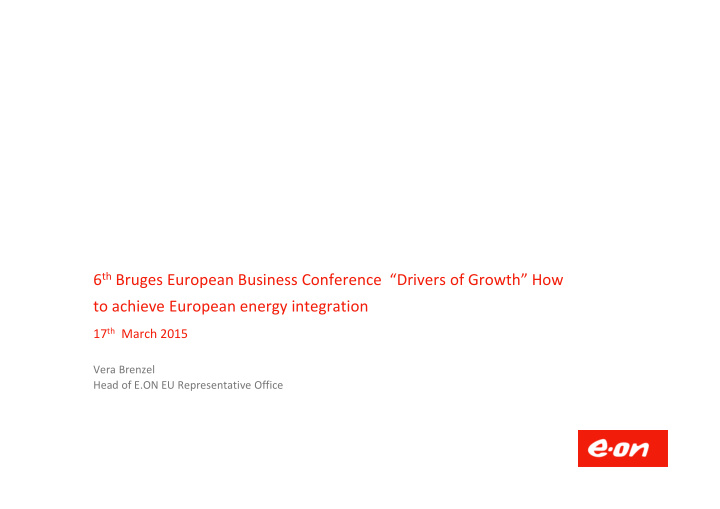



6 th Bruges European Business Conference “Drivers of Growth” How to achieve European energy integration 17 th March 2015 Vera Brenzel Head of E.ON EU Representative Office
Energy Union – five dimensions 1. Energy security, solidarity and trust: diversification of gas supplies, EU energy and climate diplomacy on global energy markets 2. Internal Energy Market: trigger investments, reduce market concentration, increase competition (or state aid if there is market failure), regional coordination (like Pentalateral Forums), strengthen ACER 3. Energy efficiency: increase Member States’ energy efficiency efforts, transport and heating sectors, protection of vulnerable customers 4. Decarbonisation: ETS reform, including transport sector, expand RES technologies cost ‐ efficiently 5. Research and Innovation: nuclear energy, CCS, multi ‐ disciplinary scientific initiative to define decarbonisation pathways 2 Vera Brenzel 17th March 2015
Costs of lack of Energy Union Estimated welfare loss for the EU due to gas market inefficiency: 11 ‐ 18 bln EUR/year [ACER*] 30 bln EUR/year [Booz&Co**] Per household, split by Member States: Conclusion: The costs are mostly borne by customers in CEE region Source: ACER* *ACER, Annual Report on the Results of Monitoring the Internal Electricity and Natural Gas Markets in 2012 , November 2013 **Booz&Co report for DG ENER, Benefits of an Integrated European Energy Market , July 2013
1. Security of gas supply: what is the key issue? Prices Infrastructure Source: zerohedge Source: DG Ener 4 Vera Brenzel 17th March 2015 4
2. EU internal energy market or 28x chaos? Political drivers Commercial drivers Innovation: New technologies shape future energy landscape Structural change: fossil/RES – Centralised/distributed generation Markets: one regulatory framework for highest performance: IEM! Volatility. Structural uncertainty, no investment appetite, SOS! 5 Vera Brenzel 17th March 2015
2. IEM: what is key for electricity? Capacity markets Disconnection of wholesale electricity prices from complete power costs increase of non market based support Price Marginal costs Demand Contribution to fix costs (CAPEX, staff etc.) Market price Supply Short term marginal costs (fuel, CO2…) MW Dispatch function Investment function 6 Vera Brenzel 17th March 2015
2. IEM: Innovations need a capacity market too Endorsement of investment and innovation capability and readiness needed Intensive competition between all available options (generation, flexibility, storage) Incentives for innovation Requirements : As little public influence as needed Focus one target – one instrument Market ‐ oriented and non ‐ discrinatory regime, EU compatible Moderate contract duration to allow market entry of innovative technologies European coordination and definition of generation adequacy 7 Vera Brenzel 17th March 2015
2. IEM: Distribution grids face significant challenges Installed RES capacity in E.DIS Distrib. grid Challenges Originally distribution grids were built to in MW transport electricity according to maximum 8,000 load Today, installed RES capacity corresponds to 6,500 factor 3 ‐ 5 of maximum load in some parts of DE 4,900 Accordingly, distribution grids need to expand 3,800 4,000 significantly 3,200 2,700 100% 2,100 Max. load 1,110 160 0 1999 2001 2003 2005 2007 2009 2011 2013 July 8 Vera Brenzel 17th March 2015
2. IEM: E.ON testing new technologies in pilot projects PV/wind In ‐ feed into Variable distribution transformers low/medium voltage grids intelligent network management Future grid operation 2020 e ‐ home Energy project Technical know ‐ how of regional energy supply is the basis of a holistic smart grid innovation concept 9 Vera Brenzel 17th March 2015
2. IEM: What‘s driving electricity prices? Average power price for a 3 ‐ person household in Germany (ct/kWh) 28,84 29,13 annual consumption 3.500 kWh Source: BDEW, Stand: 05/2014 2,05 2,05 25,23 25,89 0,009 0,250 0,250 0,092 0,329 23,21 23,69 0,178 0,126 2,05 2,05 0,151 20,64 21,65 5,277 6,24 0,03 0,002 2,05 2,05 3,592 0,13 3,530 16,11 17,19 17,96 18,66 19,46 0,23 2,05 2,05 1,31 1,79 2,05 1,79 0,20 1,79 17,11 16,53 1,16 1,79 1,79 1,79 2,05 0,29 1,02 2,05 1,79 0,34 2,05 0,08 4,60 0,88 1,79 0,09 2,05 0,34 4,13 4,65 1,79 0,77 13,94 14,32 3,71 0,69 3,78 4,03 0,28 1,79 1,79 0,31 0,51 1,79 1,79 3,46 0,42 1,79 2,33 0,26 3,30 1,53 0,35 1,79 1,28 2,68 1,79 2,28 0,20 0,13 2,57 2,48 0,25 0,20 1,79 1,79 2,37 2,22 1,92 1,97 14,42 14,12 14,17 13,89 13,87 13,80 12,91 12,99 12,19 11,72 11,60 11,22 10,85 10,25 9,70 8,62 8,58 1998 1999 2000 2001 2002 2003 2004 2005 2006 2007 2008 2009 2010 2011 2012 2013 2014 Erzeugung, Transport, Vertrieb MwSt. Konzessionsabgabe EEG-Umlage* KWK-Aufschlag §19 StromNEV-Umlage Offshore-Haftungsumlage abLa-Umlage Stromsteuer * ab 2010 Anwendung AusgleichMechV 10 Vera Brenzel 17th March 2015
3. Decarbonisation: ETS needs stability now Current Market Situation – until 2020 auction volumes 11 Vera Brenzel 17th March 2015
3. Decarbonisation: The RES increase challenge EU RES growth Support scheme options 2013 ≈ 21% No RES target 5% biomass 10% hydro 6% intermittent National targets_ Market fragmentation 21% of electricity mix today to 45% by 2030 2030 ≈ 45% EU RES targets with harmonised Support schemes 5% biomass 10% hydro EU RES targets through ETS (mature RES) and a 5x increase in R&D support intermittent generation? (immature RES) 12 Vera Brenzel 17th March 2015
Conclusion and recommendations for the Energy Union Diversify gas supplies Define a sound basis for future public interventions Ensure market integration of renewable support Phase out RES priority dispatch → balance responsibility Ensure cross border trade in renewable energy Introduce coordinated regional capacity markets and improve EOM market Take demand ‐ side response into consideration to solve the adequacy issue (e.g. flexibility options) Objective: Use the IEM to its full extent, avoid unnecessary interventions, introduce a capacity market 13 Vera Brenzel 17th March 2015
E.ON ‐ New Strategy 14 Vera Brenzel 17th March 2015
Recommend
More recommend